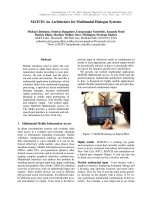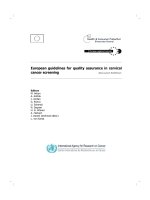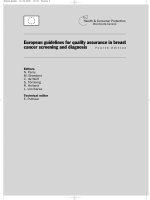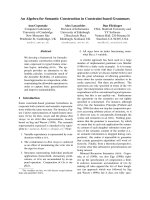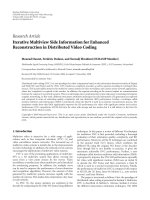An architecture for enhanced assurance in e health systems
Bạn đang xem bản rút gọn của tài liệu. Xem và tải ngay bản đầy đủ của tài liệu tại đây (2.92 MB, 275 trang )
AN ARCHITECTURE FOR ENHANCED
ASSURANCE IN E-HEALTH SYSTEMS
Yin-Miao Vicky Liu
Bachelor of Business Computing, QUT 1993
Master of Information Technology (Research), QUT 2005
Information Security Institute
Faculty of Science and Technology
Queensland University of Technology
A thesis submitted to the Queensland University of Technology
in accordance with the regulations for
Degree of Doctor of Philosophy
May 2011
Declaration
The work contained in this thesis has not been submitted for a degree or
diploma at any other higher education institution. To the best of my
knowledge and belief, this thesis contains no material previously published or
written by another person except where due reference is made.
Signature :
Date:
i
Abstract
Notwithstanding the obvious potential advantages of information and
communications technology (ICT) in the enhanced provision of healthcare
services, there are some concerns associated with integration of and access
to electronic health records. A security violation in health records, such as an
unauthorised disclosure or unauthorised alteration of an individual‘s health
information, can significantly undermine both healthcare providers‘ and
consumers‘ confidence and trust in e-health systems. A crisis in confidence
in any national level e-health system could seriously degrade the realisation
of the system‘s potential benefits.
In response to the privacy and security requirements for the protection of
health information, this research project investigated national and
international e-health development activities to identify the necessary
requirements for the creation of a trusted health information system
architecture consistent with legislative and regulatory requirements and
relevant health informatics standards. The research examined the
appropriateness and sustainability of the current approaches for the
protection of health information. It then proposed an architecture to facilitate
the viable and sustainable enforcement of privacy and security in health
information systems under the project title ―Open and Trusted Health
Information Systems (OTHIS)‖. OTHIS addresses necessary security
controls to protect sensitive health information when such data is at rest,
during processing and in transit with three separate and achievable security
function-based concepts and modules: a) Health Informatics Application
Security (HIAS); b) Health Informatics Access Control (HIAC); and c) Health
Informatics Network Security (HINS).
The outcome of this research is a roadmap for a viable and sustainable
architecture for providing robust protection and security of health information
including elucidations of three achievable security control subsystem
requirements within the proposed architecture. The successful completion of
two proof-of-concept prototypes demonstrated the comprehensibility,
feasibility and practicality of the HIAC and HIAS models for the development
ii
and assessment of trusted health systems. Meanwhile, the OTHIS
architecture has provided guidance for technical and security design
appropriate to the development and implementation of trusted health
information systems whilst simultaneously offering guidance for ongoing
research projects. The socio-economic implications of this research can be
summarised in the fact that this research embraces the need for low cost
security strategies against economic realities by using open-source
technologies for overall test implementation. This allows the proposed
architecture to be publicly accessible, providing a platform for interoperability
to meet real-world application security demands. On the whole, the OTHIS
architecture sets a high level of security standard for the establishment and
maintenance of both current and future health information systems. This
thereby increases healthcare providers‘ and consumers‘ trust in the adoption
of electronic health records to realise the associated benefits.
Keyword:
security architecture of health information systems, security for health
systems, security in health informatics
iii
Acknowledgements
This study would not have been possible without those who assisted and
guided me in various ways through the course of this research project. I
would like to express my deepest and most sincere appreciation to them.
I would like to thank my Principal Supervisor, Professor Emeritus William
(Bill) Caelli, AO, for his wealth of knowledge and experience in information
security, marvellous guidance, and tremendous support. Indeed, it has been
a privilege and a pleasure to undertake my masters by research and PhD
studies under his guidance and supervision. Professor Caelli plays such an
active role in the national and international information security community, in
particular, his passions in research to educate people and to share his
incredible wealth of wisdom. I would like thank my former Associate
Supervisor Dr. Lauren May for providing invaluable advice, guidance and
constant encouragement throughout this research. I also thank my Associate
Supervisor, Adjunct Associate Professor Jason Smith for his guidance to this
study. My gratitude goes to my former Associate Supervisor Professor Peter
Croll for his insightful advice particularly during the early stages of the
development of the architectural concept and the creation and demonstration
of the SELinux-based system. I would like to express my appreciation to Ms.
Rachel Cobcroft for her meticulous and professional editing work on this
thesis.
I am most grateful for the wonderful support and understanding from my
mother, sister, and dear friends. I would like to give special thanks to Sr.
Uriela Emm for her continuous encouragement and friendship that has been
such a vital strength throughout this study. My gratitude goes to Dr. Taizan
Chan for his kind wishes and encouragement at all times. Last but not least,
my heartfelt thanksgiving goes to my God for the provision, strength, wisdom,
and understanding needed for this journey.
iv
Table of Contents
CHAPTER 1
RESEARCH OVERVIEW ............................................................................................... 1
1.1
DESCRIPTION OF THE RESEARCH PROBLEM INVESTIGATED .......................................................................1
1.2
THE OVERALL OBJECTIVES OF THE STUDY ............................................................................................. 2
1.3
THE SPECIFIC AIMS OF THE STUDY ...................................................................................................... 2
1.4
AN ACCOUNT OF RESEARCH PROGRESS LINKING THE RESEARCH PAPERS .....................................................4
1.4.1
Chapter 3: Strengthening Legal Compliance for Privacy in Electronic Health Information
Systems: A Review and Analysis..................................................................................................... 6
1.4.2
Chapter 4: A Sustainable Approach to Security and Privacy in Health Information
Systems 7
1.4.3
Chapter 5: Privacy and Security in Open and Trusted Health Information Systems ........8
1.4.4
Chapter 6: Open and Trusted Health Information Systems/Health Informatics Access
Control (OTHIS/HIAC) .....................................................................................................................9
1.4.5
C
A“
A
A
I
1.4.6
Chapter 8: A Test Vehicle for Compliance with Resilience Requirements in Index-based
-Based E-health Environment ...11
E-health Systems ..........................................................................................................................13
1.5
RESEARCH SCOPE .........................................................................................................................14
1.6
RESEARCH CONTRIBUTIONS AND OUTCOMES......................................................................................14
1.7
THESIS FORMAT ...........................................................................................................................15
1.8
THESIS STRUCTURE .......................................................................................................................15
1.9
LIST OF PUBLICATIONS ..................................................................................................................16
1.10
INDIVIDUAL CONTRIBUTION .......................................................................................................18
CHAPTER 2
LITERATURE REVIEW................................................................................................ 21
2.1
THE SIGNIFICANCE OF THE SECURITY PROTECTION FOR HEALTH INFORMATION SYSTEMS ..............................21
2.2
OVERALL NATIONAL E-HEALTH ARCHITECTURES ..................................................................................23
2.2.1
Au
2.2.2
C
2.2.3
National Health Service (NHS) in England .....................................................................28
2.2.4
German national e-health project .................................................................................30
2.2.5
The Dutch national e-health strategy ............................................................................33
2.2.6
U“A N
2.3
-health strategy ...........................................................................23
E
H
H
R
“
I
EHR“ B
N
I
.................26
NHIN ................................................ 34
ACCESS CONTROL MANAGEMENT IN HEALTH INFORMATION SYSTEMS......................................................37
2.3.1
Discretionary Access Control (DAC) ...............................................................................37
2.3.2
Mandatory Access Control (MAC) ..................................................................................39
2.3.3
Role-Based Access Control (RBAC) .................................................................................40
v
2.3.4
2.4
Rethinking access control models in health information systems ................................. 41
APPLICATION SECURITY IN HEALTH INFORMATION SYSTEMS................................................................... 43
2.4.1
Healthcare application security on a Web Services platform ........................................ 44
2.4.2
Health Level Seven (HL7) v3 standard ........................................................................... 45
2.4.3
Healthcare data protection for legal compliance .......................................................... 47
2.5
COMMUNICATION SECURITY IN HEALTH INFORMATION SYSTEMS ............................................................ 50
2.5.1
Common network security measures ............................................................................ 51
2.5.2
Identification and authentication services in healthcare .............................................. 51
2.5.3
Network communication gateway connecting to national e-health infrastructure ...... 52
2.6
STANDARDS AND SPECIFICATIONS .................................................................................................... 55
2.6.1
OSI 7498-1, OSI 7498-2 and TCP/IP ............................................................................... 55
2.6.2
ISO 27799 Health informatics -- Information security management in health using
ISO/IEC 27002 .............................................................................................................................. 58
2.6.3
CEN 13606 Health information Electronic health record communication .................. 59
2.6.4
ISO/TS 18308 2005 Health informatics Requirements for an electronic health record
architecture ................................................................................................................................. 60
2.6.5
HL7 v3 ............................................................................................................................ 61
2.6.6
openEHR Architecture ................................................................................................... 61
2.6.7
NI“T
2.6.8
NEHTA
2.6.9
OASIS and W3C standards ............................................................................................. 63
2.7
.................................................................................................... 62
.......................................................................... 62
INSTRUMENTS USED IN EHR SYSTEMS .............................................................................................. 65
2.7.1
Healthcare smart cards ................................................................................................. 65
2.7.2
Microsoft Health Vault and Google Health ................................................................... 66
2.8
LIMITATIONS OF EXISTING APPROACHES ............................................................................................ 66
2.9
REFERENCES ............................................................................................................................... 67
CHAPTER 3
STRENGTHENING LEGAL COMPLIANCE FOR PRIVACY IN ELECTRONIC HEALTH
INFORMATION SYSTEMS: A REVIEW AND ANALYSIS ...................................................................... 77
3.1
INTRODUCTION............................................................................................................................ 78
3.2
SECURITY AND PRIVACY ................................................................................................................. 82
3.2.1
Information Security ...................................................................................................... 82
3.2.2
E-Health and Privacy ..................................................................................................... 82
3.3
CURRENT AND PREVIOUS E-HEALTH MANAGEMENT SYSTEMS ............................................................... 84
3.3.1
E-Health Initiatives ........................................................................................................ 84
3.3.2
E-health Concerns and Considerations .......................................................................... 86
3.4
AN OVERVIEW OF PRIVACY LAWS AND LEGISLATION RELATED TO HEALTH INFORMATION PROTECTION ......... 87
3.4.1
USA Privacy Laws and Health-related Privacy Legislation ............................................. 88
vi
3.4.2
3.5
Australian Privacy Laws and Health-related Privacy Legislation ...................................92
SECURITY EVALUATION FOR HEALTH INFORMATION SYSTEMS ...............................................................95
3.5.1
ICT Security Evaluation Schemes ...................................................................................96
3.5.2
Essential Concepts of the CC ..........................................................................................97
3.5.3
Protection Profiles .........................................................................................................98
3.5.4
Privacy Requirements and CC PPs................................................................................100
3.6
PROTECTION AND ENFORCEMENT USING CRYPTOGRAPHY ..................................................................102
3.7
SOME IMPLICATIONS AND CONCLUSIONS ........................................................................................103
3.8
REFERENCES..............................................................................................................................107
CHAPTER 4
A SUSTAINABLE APPROACH TO SECURITY AND PRIVACY IN HEALTH INFORMATION
SYSTEMS
111
4.1
INTRODUCTION ..........................................................................................................................111
4.2
ACCESS CONTROL.......................................................................................................................113
4.2.1
“
P
I
“
A
C
4.2.2
Scenario 2: A Lack of Adequate Safeguards to Access UK NHS Patient Records .........115
4.2.3
Scenario 3: Significant IT Security Weaknesses Identified at USA HHS Information
....................................114
Systems 116
4.3
ACCESS CONTROL MODELS ...........................................................................................................117
4.3.1
Discretionary Access Control (DAC) .............................................................................117
4.3.2
Mandatory Access Control (MAC) ................................................................................118
4.3.3
Role-based Access Control (RBAC) ...............................................................................119
4.3.4
Rethink Access Control Models in HIS ..........................................................................120
4.4
INFORMATION PROTECTION IN THE HEALTH SECTOR .........................................................................121
4.5
HEALTH INFORMATION SYSTEM ARCHITECTURES ..............................................................................121
4.6
OPEN TRUSTED HEALTH INFORMATICS SCHEME (OTHIS) ..................................................................122
4.6.1
4.7
OTHIS Structure ...........................................................................................................122
HEALTH INFORMATICS ACCESS CONTROL (HIAC) MODEL ..................................................................123
4.7.1
Analysis of HIS Access Parameters ..............................................................................124
4.7.2
HIAC Implementation ..................................................................................................125
4.7.3
HIAC Features ..............................................................................................................128
4.8
PROTECTION AND ENFORCEMENT USING CRYPTOGRAPHY IN OTHIS ....................................................130
4.9
CONCLUSION.............................................................................................................................131
4.10
REFERENCES .........................................................................................................................132
CHAPTER 5
PRIVACY AND SECURITY IN OPEN AND TRUSTED HEALTH INFORMATION SYSTEMS
135
5.1
BACKGROUND ...........................................................................................................................135
5.2
PAPER STRUCTURE .....................................................................................................................136
vii
5.3
INTRODUCTION.......................................................................................................................... 136
5.3.1
The Need for Trusted HIS ............................................................................................. 137
5.3.2
General Health Information Systems........................................................................... 137
5.3.3
Australian national e-health initiatives ....................................................................... 138
5.4
PROPOSED ARCHITECTURE - OTHIS .............................................................................................. 139
5.4.1
OTHIS is an Open Approach ......................................................................................... 140
5.4.2
OTHIS Builds upon Trusted Systems ............................................................................ 140
5.4.3
OTHIS is a Modularised Structure ................................................................................ 141
5.5
HEALTH INFORMATICS ACCESS CONTROL (HIAC) ............................................................................. 142
5.5.1
Access Control Models ................................................................................................. 142
5.5.2
Granularity in the HIAC Model .................................................................................... 143
5.5.3
Viability of an HIAC model ........................................................................................... 143
5.6
HEALTH INFORMATICS APPLICATION SECURITY (HIAS) ...................................................................... 144
5.6.1
HIAS Legal Compliance ................................................................................................ 144
5.6.2
Web Services Security in the HIAS Model .................................................................... 145
5.6.3
Health Level 7 in the HIAS Model ................................................................................ 146
5.7
HEALTH INFORMATICS NETWORK SECURITY (HINS) ......................................................................... 147
5.8
CONCLUSION AND FUTURE WORK ................................................................................................. 148
5.9
REFERENCES ............................................................................................................................. 149
CHAPTER 6
OPEN AND TRUSTED INFORMATION SYSTEMS/HEALTH INFORMATICS ACCESS
CONTROL (OTHIS/HIAC) ............................................................................................................... 153
6.1
INTRODUCTION.......................................................................................................................... 154
6.1.1
6.2
Security Requirements for E-health ............................................................................. 155
RELATED WORK......................................................................................................................... 157
6.2.1
National E-health Transition Authority ....................................................................... 157
6.2.2
Discussion on NEHTA Approach ................................................................................... 158
6.3
OUR APPROACH OPEN AND TRUSTED HEALTH INFORMATION SYSTEMS (OTHIS) ................................ 158
6.3.1
Holistic Approach to HIS .............................................................................................. 159
6.3.2
Open Architecture ....................................................................................................... 160
6.3.3
Trusted Platform .......................................................................................................... 160
6.3.4
Modularised Architecture ............................................................................................ 161
6.4
HEALTH INFORMATICS ACCESS CONTROL (HIAC) ............................................................................. 162
6.4.1
Access Control Models ................................................................................................. 163
6.4.2
HIAC is Flexible MAC-based Architecture .................................................................... 163
6.4.3
HIAC Platform .............................................................................................................. 164
6.4.4
Flask Architecture Flexible MAC SELinux ............................................................... 164
6.4.5
Protection and Enforcement Using SELinux Policy and Profile in HIAC ........................ 165
viii
6.4.6
SELinux Concepts User Identifier, Role and Type Identifier .......................................166
6.4.7
SELinux Security Mechanisms to Protect Sensitive Health Data ..................................167
6.4.8
Example of an SELinux Policy Module ..........................................................................169
6.5
ANALYSIS..................................................................................................................................173
6.6
CONCLUSION AND FUTURE WORK .................................................................................................175
6.7
REFERENCES..............................................................................................................................177
CHAPTER 7
A SECURE ARCHITECTURE FOR AUSTRALIA S INDEX BASED E-HEALTH ENVIRONMENT
179
7.1
INTRODUCTION ..........................................................................................................................180
7.2
PAPER STRUCTURE .....................................................................................................................181
7.3
SCOPE AND ASSUMPTIONS ...........................................................................................................181
7.4
RELATED WORK .........................................................................................................................182
7.4.1
Dutch National E-health Strategy ................................................................................183
7.4.2
National Health Service (NHS) in England ...................................................................184
7.4.3
USA Health Information Exchange (HIE) ......................................................................185
7.5
LESSON LEARNT FROM THE INTERNET S DOMAIN NAME SYSTEM (DNS) ...............................................186
7.6
OUR APPROACH ........................................................................................................................188
7.6.1
Index System (IS) ..........................................................................................................189
7.6.2
Healthcare Interface Processor (HIP) Proxy Service ..................................................193
7.7
ENVISIONED KEY INFORMATION FLOWS..........................................................................................197
7.8
ANALYSIS..................................................................................................................................199
7.9
CONCLUSION AND FUTURE WORK .................................................................................................201
7.10
REFERENCES .........................................................................................................................203
CHAPTER 8
A TEST VEHICLE FOR COMPLIANCE WITH RESILIENCE REQUIREMENTS IN INDEX-
BASED E-HEALTH SYSTEMS ........................................................................................................... 207
8.1
INTRODUCTION ..........................................................................................................................208
8.2
RELATED WORK .........................................................................................................................209
8.2.1
A
N
E-health Strategy ........................................................................209
8.2.2
Canadian Electronic Health Record (EHR) Solution......................................................210
8.2.3
German National E-health Project ...............................................................................211
8.3
TEST VEHICLE BACKGROUND ........................................................................................................212
8.4
IMPLEMENTATION DECISION ........................................................................................................214
8.4.1
Purpose for the Prototype Development .....................................................................215
8.4.2
Prototype Scope ...........................................................................................................215
8.4.3
Selection of Software Development Tool Sets .............................................................216
8.5
PROTOTYPE STRUCTURE ..............................................................................................................216
8.5.1
The Simulated Index System ........................................................................................217
ix
8.5.2
8.6
Virtual Health Information Systems ............................................................................ 219
KEY INFORMATION FLOWS ........................................................................................................... 223
8.6.1
E
N
P
M
H
8.6.2
Emergency Override Access ......................................................................................... 226
.................................................................. 223
8.7
RESULTS AND ANALYSIS............................................................................................................... 228
8.8
CONCLUSION AND FUTURE WORK ................................................................................................. 231
8.9
REFERENCES ............................................................................................................................. 233
CHAPTER 9
GENERAL DISCUSSION ........................................................................................... 237
9.1
RESEARCH CONTRIBUTIONS .......................................................................................................... 237
9.2
RESEARCH ANALYSIS ................................................................................................................... 239
9.3
CONCLUSION AND FUTURE WORK .................................................................................................. 242
9.4
REFERENCES ............................................................................................................................. 246
x
List of Figures
FIGURE 1 OPEN TRUSTED HEALTH INFORMATION SYSTEMS (OTHIS) .....................................................................4
FIGURE 2: PUBLICATIONS LINKED TO THE RESEARCH THEME ..................................................................................6
FIGURE 3: HEALTH INFORMATION SYSTEM ARCHITECTURE ................................................................................105
FIGURE 4: PROXY OPERATION .....................................................................................................................127
FIGURE 5: GENERAL HIS STRUCTURE ...........................................................................................................138
FIGURE 6: MODULARISED STRUCTURE OF OTHIS ...........................................................................................141
FIGURE 7: OPEN AND TRUSTED HEALTH INFORMATION SYSTEMS.......................................................................161
FIGURE 8: SELINUX PROFILE DEVELOPMENT CYCLE.........................................................................................166
FIGURE 9: AUTHORISATION PROCESS FLOW IN SELINUX ..................................................................................166
FIGURE 10: PROTECT SENSITIVE HEALTH DATA WITH SELINUX..........................................................................169
FIGURE 11: PROPOSED ARCHITECTURE OVERVIEW AND KEY INFORMATION FLOWS...............................................188
FIGURE 12: SERVICE INSTANCE RESPONSE MESSAGE FORMAT ..........................................................................192
FIGURE 13: SECURE ARCHITECTURE FOR INDEX-BASED E-HEALTH ENVIRONMENT .................................................213
FIGURE 14: PROTOTYPE STRUCTURE ............................................................................................................217
FIGURE 15: EXAMPLE OF TABLES AND VIEW OF THE DIRECTORY SERVICE DATABASE .............................................219
FIGURE 16: FLOW CHART FOR AUTHORIZATION LOGIC ....................................................................................222
FIGURE 17: ENQUIRY FOR NEW PATIENT S MEDICAL HISTORY ..........................................................................224
FIGURE 18: EMERGENCY OVERRIDE ACCESS ..................................................................................................227
xi
List of Tables
TABLE 1: (A) OSI MODEL, (B) TCP/IP MODEL, (C) GENERAL HEALTH SYSTEM ARCHITECTURE, AND (D) OTHIS ............. 43
TABLE 2: EXEMPLARY NETWORK COMMUNICATION GATEWAYS .......................................................................... 53
TABLE 3: OSI 7498-2 SECURITY SERVICES AND MECHANISMS ............................................................................. 58
TABLE 4: GENERAL STRUCTURE OF PRIVACY LEGISLATION IN AUSTRALIA ................................................................ 94
TABLE 5: (A) OSI MODEL, (B) TCP/IP MODEL AND (C) GENERAL HIS ARCHITECTURE .......................................... 122
TABLE 6: ANALYSIS OF HIS ACCESS PARAMETERS ........................................................................................... 124
TABLE 7: LINUX UID, SELINUX UID, ROLE AND TYPE...................................................................................... 167
TABLE 8: DEVELOPMENT TOOL SETS ............................................................................................................ 216
TABLE 9: OTHIS MODULES ........................................................................................................................ 238
xii
Chapter 1 Research Overview
1.1 Description of the research problem investigated
In the 21st century, Information and Communications Technology (ICT) and
its artefacts provide the critical infrastructure needed to support most
essential services, including the information services of the healthcare sector.
The use of computer-based information systems and associated
telecommunications and data network infrastructure to process, transmit, and
store health information plays an increasingly significant role in the
improvement of quality and productivity in healthcare.
Despite e-health‘s potential to improve the processing of health data,
electronic health records may inadvertently pose new threats to the
protection of sensitive health data, if not designed and managed effectively.
Moreover, e-health‘s basic confidentiality, integrity, and availability
parameters must be considered from its earliest research and development
stages. Malevolent motivations in both internal system users and external
attackers of the system could result in disclosure of confidential personal
health information on a widespread scale, and at a higher speed than
possible with traditional paper-based medical records. Unlike other industries
and enterprises, such as the banking and finance sectors, loss of privacy
through disclosure of health record data is normally not recoverable.
Namely, unlike the banking sector, a new account cannot be created along
with all other necessary identification and authentication data and processes.
Health data is usually ―locked‖ to an individual. Security violations in health
information systems, such as an unauthorised disclosure or unauthorised
alteration of individual health information, therefore have the potential for
disaster among healthcare providers and consumers.
There are some major concerns associated with the integration of, and
access to, electronic health records. Information stored within electronic
health systems is highly sensitive by its very nature. The management of
1
health records, therefore, carries clear requirements for the protection of
health record confidentiality and the maintenance of integrity.
This research addresses the shortcomings surrounding privacy and security
of contemporary ICT systems for the protection of sensitive health
information. The key research question investigated and reported upon in
this thesis is summarised as follows:
Are current approaches to the protection of the security of health
information systems appropriate and sustainable? If not, is it possible to
create a suitable trusted system architecture for security and control, with
associated management functions at each level in a health information
system, while maintaining a holistic approach to the problem?
This research proposes a secure system architecture for a health information
system that consists of a set of achievable security control modules. This
study was performed and results obtained as to whether this proposed
architecture is a viable, sustainable, and holistic approach to provide
adequate levels of security protection for health information systems.
1.2 The overall objectives of the study
In response to the health sector‘s privacy and security requirements for
contemporary health information systems, the overall goal of this research is
to propose a feasible and sustainable solution to meeting security demands
using open architecture, available technologies, and open standards. A
trusted and open system architecture is therefore needed to address the
privacy protection and security for health systems in a holistic and end-to-end
manner, and not one that involves just the data communications level using
securing messaging technology alone.
1.3 The specific aims of the study
To address privacy and security requirements at each level within a modern
health information system, this research has aimed:
2
1. To investigate electronic health management applications and
deployment activities, nationally and internationally;
2. To identify the necessary requirements and constraints for the
creation of any possible trusted information system architecture
consistent with health regulatory requirements and standards;
3. To examine the appropriateness and sustainability of the current
approaches for the protection of sensitive electronic patient data;
4. To propose a viable, open, and trusted architecture for health
information systems comprised of a set of separate but achievable
security control modules building on top of a trusted platform;
5. To develop a viable and sustainable approach to the provision of
appropriate levels of secure access control management for the
protection of sensitive health data;
6. To provide advice on the necessary security controls for the
Network and Application Levels to protect sensitive health
information in transit and under processing; and
7. To present the practicality, feasibility, clarity, and comprehensibility
of the proposed network security architecture for enabling the ready
development of systems based on the overall architecture through
the demonstration and analysis of a small experimental system.
The relevance of each specific aim above is validated through the six
published papers included in this thesis, as follows:
Chapter 3 substantiates the relevance of Aims 1 and 2;
Chapter 4 confirms the relevance of Aim 3;
Chapter 5 supports the relevance of Aim 4;
Chapter 6 authenticates the relevance of Aim 5;
Chapter 7 strongly supports the relevance of Aim 6; and
Chapter 8 verifies the relevance of Aim 7.
3
1.4 An account of research progress linking the research
papers
In order to address the security requirements for a trustworthy e-health
system in a holistic manner, the thesis proposes the Open and Trusted
Health Information Systems (OTHIS). OTHIS is an open architecture
espousing open standards and open-source technologies rather than utilising
proprietary technologies. As illustrated in Figure 1, OTHIS architecture aims
at building firmware and hardware bases on top of trusted operating systems,
to provide a solid security foundation for any secure and trusted health
information system. Without a trusted computing base, any system is subject
to compromise. Necessary healthcare security services such as
authentication, authorisation, data privacy, and data integrity can only be
confidently assured when the system foundation is trusted. Such strong
security platforms are considered necessary to ensure the protection of
electronic health information from both internal and external threats, as well
as providing conformance of health information systems to regulatory and
legal requirements.
Healthcare applications
Database management system
Middleware
HIAS
HIAC
Network management system
Operating system
HINS
Firmware
Trusted Firmware
Hardware
Trusted Hardware
Figure 1 Open Trusted Health Information Systems (OTHIS)
OTHIS is a modularised architecture for health information systems,
consisting of three separate and achievable function-based modules:
Health Informatics Access Control (HIAC): HIAC aims at addressing
a far finer level of granularity needed for verifiable security and
control management requirements in a health information system,
4
from the network, operating system, and database management
system (data accessibility at table/view, row/column, and cell levels
in databases) up to the Application Layer.
Health Informatics Application Security (HIAS): HIAS aims at
addressing data protection requirements which are reflected in law
and associated regulatory instruments. This is achieved through
practical security services provided by healthcare applications at
the data element level through to security provisions at any service
level. Thus, HIAS could cater for situations where Web Servicesbased applications and Health Level 7 (HL7) messaging and data
transfer structures are being used as the major health information
transport methodology. It aims at achieving this in a trusted,
secure, and efficient manner.
Health Informatics Network Security (HINS): HINS consists of the
appropriate Network Level security structure within a distributed
health system. HINS is aimed at the provision of services and
mechanisms to authenticate claims of identity, to provide
appropriate authorisations following authentication, to prevent
unauthorised access to shared health data, to protect the network
from attacks, and to provide secure communications services for
health data transmission over open data networks.
Figure 2 illustrates the relevance of the papers forming the basis of this
thesis. These consist of five conference papers, and one journal publication.
5
Strengthening Legal Compliance for Privacy in Electronic
Health Information systems: A Review and Analysis
Strengthening Legal Compliance for Privacy in Electronic
(EPASS 2006)
Health information systems: A Review and Analysis
(e-JHI 2008)
Republished of EPASS2006 as a journal
Health
Informatics
Application
Security
(HIAS)
Paper referenced only
Open Trusted Health Informatics Structure
(ACSW/HIKM 2008)
A Sustainable Approach to Security and
Privacy in Health Information Systems
(ACIS 2007)
Utilizing SELinux to Mandate Ultra-secure
Access Control of Medical Records
(MedInfo 2007)
Open and Trusted Information
Systems/Health Information Access Control
(OTHIS/HIAC)
Health
Informatics
Access
Control
(HIAC)
Open and
Trusted Health
Information
Systems
(OTHIS)
Privacy and Security in Open and Trusted
Information Systems
(ACSW/HIKM 2009)
Health
Informatics
Network
Security
(HINS)
“
A
A
I
Based E-health Environment
(ACSW/HIKM 2010)
A Test Vehicle for Compliance with
Resilience Requirements in Index-Based
E-health Systems
(PACIS2011)
(ACSW/ACSC 2009)
Figure 2: Publications linked to the research theme
1.4.1 Chapter 3: Strengthening Legal Compliance for Privacy in
Electronic Health Information Systems: A Review and
Analysis
This research activity has provided the relevant information for determining
the requirements for, and constraints on, the creation of any trusted
information system architecture for an electronic health system. Chapter 3
investigates electronic health management applications and deployment
activities at both national and international levels. It also analyses the
required access management in health informatics in the United States of
America and Australia.
In developing a new approach to the electronic health management
application, it is necessary to be aware of issues identified with current and
previous attempts to implement e-health activities at both national and
international levels. There are lessons to be drawn from international
experience in e-health development and implementation. This analysis also
gives a perspective on ―real-world‖ and current issues which need to be
6
addressed. Regardless of the location of the actual health system
application, be it in the UK, USA, or Australia, common inherent requirements
in any health information system are the ability to provide security and
privacy features as and where required.
It has been essential to review the USA‘s laws with regard to the protection of
health information, as well as to explore Australian Federal, State, and
Territory legislation, policies, and standards. The USA‘s Health Insurance
Portability and Accountability Act (HIPAA) 1996 provisions may have
widespread influence on the entire healthcare industry worldwide. This is in
addition to having an immediate impact on every information system that
uses or processes health information in the USA. This chapter also
investigates the Australian Federal Privacy Act 1988, and jurisdictional State
and Territory privacy and health record laws.
1.4.2 Chapter 4: A Sustainable Approach to Security and Privacy
in Health Information Systems
In examining the appropriateness and sustainability of the current
approaches for the protection of sensitive patient data, Chapter 4 identifies
and discusses recent information security violations or weaknesses found in
national infrastructure in Australia, the UK, and the USA; two of which involve
departments of health and social services. These three illustrated cases all
have a common security weakness which directly relates to access control
management. Appropriate computer-based access control schemes can be
deployed to address these information security issues.
Again, from an information security perspective, this chapter also investigates
major access control models. It argues that a radical re-think is absolutely
crucial to the understanding of access control technologies and
implementations in light of modern information system structures, legislative
and regulatory requirements, and overall security demands on operational
health information systems. This chapter proposes a viable and sustainable
approach to the provision of appropriate levels of secure access control
management under an overall trusted health informatics scheme, with a
focus on trustworthy access control mechanisms. This research therefore
7
proposes the ―Health Informatics Access Control (HIAC)‖ model within the
overall ―Open and Trusted Health Information System (OTHIS)‖ concept.
The aim is to overcome privacy and security issues which have plagued
previous attempts to advance security structures in electronic health
management systems. To determine the practical viability of a HIAC model
for health systems, this chapter reports on a HIAC proof-of-concept prototype
which was built to exploit the enhanced security features of a current trusted
operating system which, in some implementations, has been evaluated under
the ―Common Criteria‖ (international standard IS15408) paradigm. Namely, it
was built on the Security Enhanced Linux (SELinux) structures in the Red Hat
Enterprise Linux (RHEL) Version 4 operating system.
1.4.3 Chapter 5: Privacy and Security in Open and Trusted Health
Information Systems
The initial OTHIS scheme is introduced broadly in Chapter 4 in response to
the health sector‘s privacy and security requirements for a contemporary
health information system. Chapter 5 addresses the OTHIS philosophy and
architecture components.
The OTHIS philosophy aims to achieve a high level of information assurance
in health information systems. As such, the OTHIS scheme is proposed as a
holistic approach to address privacy and security requirements at each level
of a modern health information system. The aim is to ensure the protection
of data from both internal and external threats. OTHIS, it is believed, has the
capacity to ensure the legal compliance of any health information system to
appropriate legislative and regulatory requirements. In line with
contemporary concepts of open-source information technologies, OTHIS
incorporates the term ―open‖ to embrace relevant open architectures and
allied technical standards. Therefore, open-source technologies and
software products are used rather than proprietary technologies. OTHIS also
incorporates the term ―trusted system.‖ Without a relevant trusted computing
base (TCB), any system is subject to compromise. In particular, data security
at the Application Level can be assured only when the healthcare application
is operating on top of a TCB-oriented platform. This applies to all healthcare
8
applications and related databases to achieve adequate information
assurance. For this reason, OTHIS aims at overall application systems
running on top of trusted systems software, middleware, firmware, and
hardware bases.
OTHIS is a modularised architecture for health information systems. Each
module has a specific focus area. There is inevitably some overlap across
those modules, however. As stated previously, OTHIS consists of three
separate and achievable function-based modules:
HIAC;
HIAS; and
HINS.
1.4.4 Chapter 6: Open and Trusted Health Information
Systems/Health Informatics Access Control (OTHIS/HIAC)
Chapter 6 reviews the HIAC proof-of-concept prototype developed under the
overall OTHIS architecture (in Chapter 5) to exemplify improved flexibility via
SELinux policy configurations. This chapter illustrates the key SELinux
concepts and procedures for developing a security policy using SELinux
security mechanisms to protect sensitive health data stored and processed in
health information systems. This is coupled with an example coding of the
SELinux policy configurations.
In Chapter 4, the HIAC proof-of-concept prototype was developed at the early
stages of the overall SELinux operating system project development. It was
argued that previous SELinux mandatory access policy development and
management facilities were too inflexible to handle a large-scale health
system efficiently, which may involve dynamic and frequent changes to
security policies, such as adding/deleting users and applications. With the
earlier SELinux distribution, any changes and extensions made to an
SELinux system access policy would have required the source policy coding
to be recompiled and the system to be restarted. As SELinux has continued
to advance and evolve, any changes to those security policies can be
recompiled with available tools and techniques. Updated security polices can
9
then be reloaded into the system kernel without the need to restart the
system. To date, the HIAC proof-of-concept prototype has been updated to
the Fedora Core 9 operating system distribution. This has been used to
confirm the flexibility of SELinux in providing the levels of assurance required.
Increasingly, health information systems are being developed and deployed
based upon commercial, commodity-level ICT productions and systems,
commonly referred to as ―Commercial Off-the-Shelf (COTS) Systems.‖ Such
general-purpose systems have been created over the last 25 years with often
only minimal security functionality and verification. In particular, access
control at the operating system level performs a vital security function in
protecting sensitive application packages. Contemporary access control
builds on the earlier method known as ―Discretionary Access Control (DAC)‖.
The DAC structure is widely implemented to manage overall system access
control in current commodity software such as Microsoft Corporation‘s
Windows systems, open-source systems such as Linux, and the original Unix
system. Applications that rely on DAC mechanisms are vulnerable to
tampering and bypassing and normally do not allow for mandatory labelling of
all system ―objects‖. Malicious or flawed applications can easily cause
security violations in the DAC environment. This environment alone is no
longer valid for modern health information systems and, when used, is
normally supplemented by Application and Network Layer security services
and mechanisms. HIAC provides a flexible form of a Mandatory Access
Control (Flexible MAC) model, accompanied, as is the norm, by Role-Based
Access Control (RBAC) properties to simplify authorisation management.
This degree of simultaneous control, flexibility, and a refined level of
granularity is not achievable with DAC, RBAC, or even MAC individually.
This chapter argues that adoption of appropriate security technologies, in
particular Flexible MAC-oriented operating system bases, can satisfy the
requirements for the protection of sensitive health data, as the HIAC model
has demonstrated.
10
1.4.5 Chapter 7: A Secure Architecture for Australia’s IndexBased E-health Environment
Generally, health information is stored over a number of different computer
systems under diverse management regimes working at different levels, such
as geographic, enterprise, and so forth. For the provision of national level
healthcare information services at both patient and healthcare provider
levels, a national index system must be available for the provision of directory
services to determine the distributed locations of the source systems holding
the related health records. Chapter 7 addresses this need by proposing a
connectivity architecture with the required structures to support secure
communications between healthcare providers and the Index System in the
national e-health environment, including:
The Index System itself; and
The proposed Healthcare Interface Processor (HIP) module.
The Index System, a centralised facility run at a national level, should be built
on a high-trust computer platform to perform authentication and indexing
services. This proposal draws on important lessons from the Internet‘s
Domain Name System (DNS) for the development and deployment of the
national healthcare Index System. Particularly, the chapter argues that a
fundamental security issue, that of name resolution, must be addressed prior
to the initiation of interactions between the healthcare providers and national
Index System. This chapter, therefore, proposes a trusted architecture not
only providing the indexing service but also incorporating a trusted name
resolution scheme for the enforcement of communicating to the authorised
Index System.
This thesis‘ design philosophy of HIP draws on principles used in the original
―Interface Message Processor (IMP)‖ system of the Advanced Research
Projects Agency Network (ARPANET), to isolate the disparate ―downstream‖
systems and associated networks of users connected to the ARPANET
network. The design rationale underlying HIP, a resilient and qualified facility
built on top of a trusted base-embedded hardware and software platform, is
11


